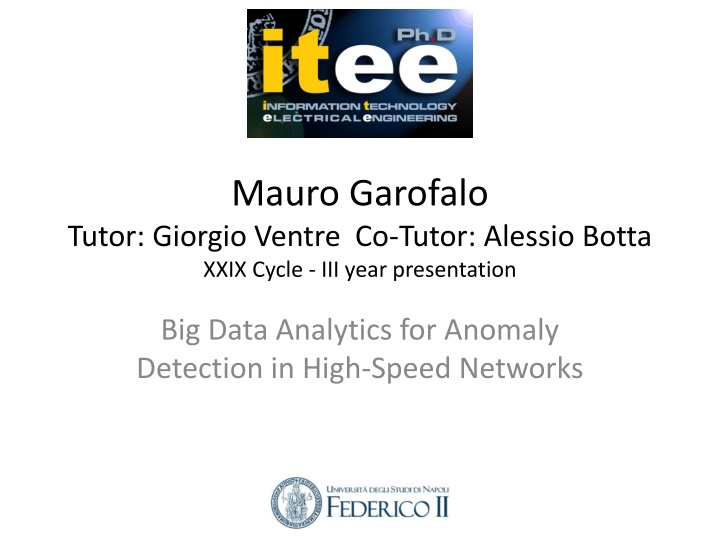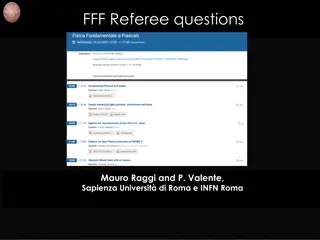
Anomaly Detection in High-Speed Networks: Understanding Data Growth and Network Anomalies
"Explore the world of anomaly detection in high-speed networks with Mauro Garofalo's research on big data analytics. Discover how anomalies in internet data growth and network behavior are detected and addressed, including the impact of both malicious and non-malicious activities."
Uploaded on | 1 Views
Download Presentation

Please find below an Image/Link to download the presentation.
The content on the website is provided AS IS for your information and personal use only. It may not be sold, licensed, or shared on other websites without obtaining consent from the author. If you encounter any issues during the download, it is possible that the publisher has removed the file from their server.
You are allowed to download the files provided on this website for personal or commercial use, subject to the condition that they are used lawfully. All files are the property of their respective owners.
The content on the website is provided AS IS for your information and personal use only. It may not be sold, licensed, or shared on other websites without obtaining consent from the author.
E N D
Presentation Transcript
Mauro Garofalo Tutor: Giorgio Ventre Co-Tutor: Alessio Botta XXIX Cycle - III year presentation Big Data Analytics for Anomaly Detection in High-Speed Networks
Short Bio Graduation: MSc in Computer Engineering at University of Napoli Federico II DIETI Group: COMICS Fellowship: MIUR research grant Collaboration: DAME Mauro Garofalo 2
Credits Summary Credits year 1 Credits year 2 Credits year 3 1 2 3 4 5 6 1 2 3 4 5 6 1 2 3 4 5 6 Estimated 15 Estimated 20 Estimated Summary 12 5,7 42 60 Summary 22 Summary bimonth bimonth bimonth bimonth bimonth bimonth bimonth bimonth bimonth bimonth bimonth bimonth bimonth bimonth bimonth bimonth bimonth bimonth Check Total 34 30-70 15 10-30 56 131 80-140 60 180 3 3 2 5 6 3 7 6 6 Modules Seminars Research 2 2 0 0,6 6,4 10 0,9 9,1 10 2,2 1,8 10 6 0,2 34 60 0,2 2,8 10 4,6 0,4 9,6 10 3 7 1 9 6 5 4,4 10 10 10 10 6,8 10 4 10 10 5 4 10 10 10 10 10 10 39 60 33 60 56 60 10 10 9,6 10 10 10 180 Summer Schools Summer School on Computer Security & Privacy - Building Trust in the Information Age, Pula (CA) Mauro Garofalo 3
Scenario Internet Data growth Velocity Variety Volume Computer networks are crucial to daily life communication, banking, office Data grown in 3 directions: Volume, Velocity, and Variety Understanding what is happening in the networks becomes an increasingly complex task Mauro Garofalo 4
Anomaly Detection An Anomaly Detection System (ADS) analyzes the characteristics of the input data with the aim of discovering deviations from a normal pattern of behavior. Anomaly is a pattern in the data that does not conform to the expected behavior. Also referred to as outliers, exceptions, aberrations, etc. Abnormal events will occur far frequently compared to normal ones. Anomaly Example Points Anomalies Contextual Anomaly Mauro Garofalo 5
Network Anomalies Network anomalies could be generated both by malicious and non-malicious activities Malicious activities (attacks) Net scans Port Scans DoS/DDoS Non-malicious activities network misconfiguration traffic discrimination (violation of Net Neutrality) Mauro Garofalo 6
Malicious Activities Detection Due the rapid evolution of attack techniques, it is crucial to use detection methods that are effective against both new attacks and variations of known attacks. Internet Capture Traffic (Packet/Flow) Anomaly-based IDS (ADS) have the ability to detect this kind of attacks Traffic feature distribution Anomaly Preprocessing Traffic distributed in destination port space and concentrated on single destination host. Port scan Anomaly Detection Matching Mechanism Traffic distributed in destination address space and concentrated on limited number of destination ports Traffic distributed in source address space and concentrated on limited number of destination addresses. Network scan ALERT DoS/DDoS Mauro Garofalo 7
Challenges Defining the normality region/model is challenging Boundaries between normal and anomalous behavior are not precise Normal behavior keeps evolving, so the current notion of normality might not be adequate in future. High False Positive Rate. Lack of publicly available labeled datasets (i.e. ground truth) for training/validation Mauro Garofalo 8
Malicious AD - Related Work Flow Monitoring Li, B., et al. (2013). A survey of network flow applications, Journal of Network and Computer Applications, 36(2), 567 581. Hofstede, R, et al. (2014). Flow Monitoring Explained: From Packet Capture to Data Analysis With NetFlow and IPFIX. IEEE Communications Surveys & Tutorials, 16(4), 2037 2064. Glatz, E., et al. (2012). Classifying internet one-way traffic. ACM SIGMETRICS Performance Evaluation Review, 40(1), 417. Flow-based Anomaly Detection Lakhina, A., et al. (2004). Characterization of network-wide anomalies in traffic flows. In Proceedings of the 4th ACM SIGCOMM conference on Internet measurement - IMC 04 (Vol. 6, p. 201). Muraleedharan, N. (2008). Analysis of TCP flow data for traffic anomaly and scan detection. In 2008 16th IEEE International Conference on Networks (pp. 1 4). Androulidakis, G., et al. (2009). Network anomaly detection and classification via opportunistic sampling. IEEE Network, 23(1), 6 12. Brauckhoff, D., et al. (2012). Anomaly Extraction in Backbone Networks Using Association Rules. IEEE/ACM Transactions on Networking, 20(6), 1788 1799. De Assis, et al. (2013). A novel anomaly detection system based on seven-dimensional flow analysis. In GLOBECOM - IEEE Global Telecommunications Conference (pp. 735 740). Big Data architecture for network monitoring Marchal, S., et al. (2014). A Big Data Architecture for Large Scale Security Monitoring In 2014 IEEE International Congress on Big Data (pp. 56 63). IEEE. Cao, L., et al. (2014). Interactive outlier exploration in big data streams. Proceedings of the VLDB Endowment, 7(13), 1621 1624. Solaimani, M., et al. (2014). Statistical technique for online anomaly detection using Spark over heterogeneous data from multi-source VMware performance data. In 2014 IEEE International Conference on Big Data (Big Data) (pp. 1086 1094). Mauro Garofalo 9
Malicious AD - Contribution We introduce a general methodology to acquire and store flows in high-speed networks. We propose and implement an architecture for flow- based ADS looking for IPs responsible of malicious activities . We exploit a BDA framework to reduce the response time of the ADS. We validate our ADS with real backbone traffic. Mauro Garofalo 10
Non Malicious Anomaly Detection Network Neutrality The ability of all Internet users to access the content or applications of their choice. Assurance that all traffic on the Internet is treated equally, whatever its source, content or destination. Absence of unreasonable discrimination on the part of network operators in transmitting Internet traffic. Network Neutrality involves different aspects of interest Economic, Regulatory and Privacy a wide range of stakeholders Policy makers, Service providers, and Researchers Mauro Garofalo 11
Net Neutrality - Related Work Main topics Video popularity, user behavior, delivery policies, and some performance of YouTube and Daily Motion Cha, Meeyoung, et al. (2007) I tube, you tube, everybody tubes: analyzing the world's largest user generated content video system. In ACM Internet Measurement Conference (IMC) (Vol. New York, pp. 1 14). Plissonneau, L. et al. (2012). Analyzing the impact of YouTube delivery policies on user experience. In Teletraffic Congress (ITC 24), 2012 24th International (pp. 1 8). Plissonneau, L., & Biersack, E. (2012). A longitudinal view of HTTP video streaming performance. In Proceedings of the 3rd Multimedia Systems Conference on - MMSys 12 (p. 203). Infrastructures Padmanabhan, V. N., & Subramanian, L. (2001). An investigation of geographic mapping techniques for internet hosts. ACM SIGCOMM Computer Communication Review, 31(4), 173 185. Calder, M., et al. (2013). Mapping the expansion of Google s serving infrastructure. In Proceedings of the 2013 conference on Internet measurement conference - IMC 13 (pp. 313 326). Mauro Garofalo 12
Net Neutrality - Contribution We introduce a general methodology to acquire and analyze performance statistics We measure, analyze, and compare the performance of YouTube, Vimeo, and Dailymotion, from several locations around the world and from a user viewpoint We also provide insights on geographical location of the infrastructure Mauro Garofalo 13
Malicious Anomaly Detection Mauro Garofalo 14
BDA for Flow-Based Anomaly Detection SOFTFLOWD Exporter: Reads Flow cache, prepares and sends export flows Flow cache: Creates/Removes/Updates flow records BACKBONE LINK Flow Key Flow start time Flow last update time Flow Characteristics Meter . Netflow v5/v8/v9 or IPFIX Collector: Receives export packets, interfaces to applications Message Broker Speed Layer Streaming NFCAPD Storage Batch Layer NFDUMP HDFS
The Detection Algorithm 1. The algorithm grouped the flow records in time bin (i.e. 30 seconds). 2. Given a time bin, for each source IPs the ratio #?????????????? #????????????? is calculated. 3. If the ratio exceed the threshold the IP is considered as a generator of anomalous flows. A flow is a set of packets passing an Observation Point in the network during a certain time interval. All packets belonging to a particular flow have a set of common properties . IETF RFC7011
What about the data? MAWI archive Traffic captured from a transpacific backbone link Publicly accessible 15 minutes of daily captured traffic MAWILab Archive of labeled anomalies in the traces of the MAWI archive. Publicly accessible Unsupervised methodology using a combination of four anomaly detectors to provide the labeled dataset. Hough transform, the Gamma distribution, the Kullback-Leibler divergence, and the Principal Component Analysis. It can be considered as Gold Standard Mauro Garofalo 18
Evaluation of Anomaly Detector Confusion Matrix ?? Predicted condition ????????? = ??? = ?? + ?? Total Condition positive Condition negative population condition positive condition negative True Positive False Negative Actual condition ???????? =?? + ?? ? + ? False Positive True Negative Accuracy is not appropriate for evaluating methods for rare event detection Network traffic dataset with 99.9% of normal data and 0.1% of intrusions a trivial classifier (where everything is labeled as normal) can achieve 99.9% accuracy! Mauro Garofalo 19
Algorithm Evaluation Results are related to MAWI and MAWILab traces of October 2014 Red line shows the precision using MAWILab as ground truth We applied a rule-based refinement to False Positive IPs Port scan rule: #?????????????? #???????????????? Net scan rule: #?????????????? #????????????? Blu line shows the precision after a refinement process. Precision Comparison Percentage Change 1.000 Date TP FP PPV TP FP PPV 0.800 21/10/2014 71 246 0,224 300 17 0,946 322,54% 0.600 25/10/2014 41 206 0,166 246 1 0,996 500,00% 0.400 26/10/2014 47 203 0,188 250 0 1 431,91% 0.200 27/10/2014 59 237 0,199 275 21 0,929 366,10% 0.000 MAWILab + Rules MAWILab 1 6 11 MAWILab 16 21 26 31 MAWILab + Rules Mauro Garofalo 20
Non Malicious Anomaly Detection Mauro Garofalo 21
Methodology and tools We used an extensive infrastructure of 200 PlanetLab nodes from 36 countries We performed 24h daily measurements over 6 months We grouped videos in 4 category depending on their popularity ~500 views, 10K < views < 120K, 120K < views < 1M, and views > 1M For each provider we download two videos for each category Mauro Garofalo 22
Methodology and tools PlanetLab Node Exporting: Create zip files for each provider and upload them to the server Throughput measurement RTT & Path Video Download ping youtube-dl lsof traceroute x200 Nodes Centralized Server Statistics & Plots Database Collector: Receives the providers performance measurements from all PlanetLab nodes Video Hosting Providers 23 Mauro Garofalo
Video Service Providers Infrastructure Dailymotion Entire infrastructure in France (i.e. Paris) (but) Abnormal activities by some nodes outside France. Vimeo Used the very spread and very high performance Akamai s CDN. Clients directed to the same server, besides day time or network overload YouTube Cache-servers in almost all the tested countries Delivery strategy assessing both the distance and the load Mauro Garofalo 24
Daily patterns? Dailymotion Throughput values of Vimeo and YouTube are one order of magnitude higher then Dailymotion Video less views have slightly high throughput Vimeo No throughput variation in peak times Interquartile ranges (intervals defined by 1st and 3rd quartile) are very large YouTube Mauro Garofalo 25
Throughput and RTT by country Average Throughput Dailymotion has the worst performance, and most of its clients show throughput values smaller than 500 KiB/s. YouTube and Vimeo have similar patterns for all video categories Vimeo has better performance Average RTT Dailymotion's RTT values are larger in comparison to its competitors. Distributed infrastructures, as Akamai CDN for Vimeo, and Google cache-servers for YouTube, show better performance in terms of RTT. Mauro Garofalo 26
Conclusions Malicious Anomaly Detection We proposed and implemented a flow-based ADS that allows to acquire and analyze network traffic looking for IPs responsible of malicious activities. We used a BDA framework to reduce the response time of the ADS. We performed a comparison of our system with MAWILab archive, with validation purposes. Non Malicious Anomaly Detection We proposed a methodology that, regardless the type of provider, allows to acquire and analyze performance data and qualitative considerations about the infrastructure of the providers. We performed a performance comparison of three video hosting services, namely Dailymotion, Vimeo and YouTube, estimating the throughput, RTT, number of hops, and geography location of their infrastructures. Mauro Garofalo 27
Publications Botta, A., Avallone, A., Garofalo, M., and Ventre, G ., A User-Oriented Performance Comparison of Video Hosting Services submitted to Computer Communication, 2017. Botta, A., Avallone, A., Garofalo, M., and Ventre, G ., Internet streaming and network neutrality: Comparing the performance of video hosting services, ICISSP2016. Garofalo M., Botta, A., and Ventre, G., Astrophysics in the Big Data era: Challenges, Methods, and Tools , AstroInformatics, 2016. Brescia, M., Cavuoti, S., Garofalo, M., et al, DAMEWARE: A Web Cyberinfrastructure for Astrophysical Data Mining , PASP, Vol. 126, P. 783-797, ISSN: 0004-6280, 2014. Garofalo, M., et al., Acceleration of Machine Learning Models based on GPGPU technology for fast data mining in multidisciplinary physical environments , GPU2014. Mauro Garofalo 28
TRAFFIC BREACKDOWN TCP ICMP UDP FLOWS 8.13% 73.38% 18.49% PACKETS 60.1% 10.9% 29.0% 0.0% 10.0% 20.0% 30.0% 40.0% 50.0% 60.0% 70.0% 80.0% 90.0% 100.0% 30

















